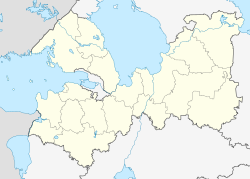Priosersk
| city
Priosersk
Priozersk
|
||||||||||||||||||||||||||||||||||||||
|
||||||||||||||||||||||||||||||||||||||
|
||||||||||||||||||||||||||||||||||||||
| List of cities in Russia | ||||||||||||||||||||||||||||||||||||||
Priosersk ( Russian Приозе́рск , Finnish Käkisalmi , Swedish Kexholm ) is a city in the northwestern Russian Leningrad Oblast . It has 18,933 inhabitants (as of October 14, 2010).
geography
The city is located on the Karelian Isthmus about 140 km north of the oblast capital Saint Petersburg in the area where the Wuoksa (Vuoksi) flows into Lake Ladoga .
Priosersk is administratively directly subordinate to the Oblast and at the same time the administrative center of the Rajon of the same name .
history
The place was first mentioned in 1143 as Korela Fortress (cf. Karelia or Karelians ) and was in the following period in the area of military conflicts between Russians and Swedes .
In 1310, the Novgorod Republic built the so-called Old Fortress on the Wuoksa Island of Detinez as one of its northern outposts . A trading settlement was established on the neighboring island of Spasski . In 1323 Novgorod took possession of the surrounding area.
With Novgorod, Korela came into the possession of the Grand Duchy of Moscow in 1479 , which appointed a governor here . The place soon extended to the left ( Fjodorowski Possad ) and right ( Orechowski Possad ) banks of the Wuoksa and also became a bishopric.
From 1581 to 1595 and from 1611 to 1710 the town and fortress were owned by Sweden . In 1611 they were renamed Kexholm ( Swedish for cuckoo island , in the old spelling) and became the administrative center of the county of the same name . Under Swedish rule, the New Fortress was built on the northern Spassky Island in the 17th century .
During the Great Northern War , the city was captured by Russian troops in September 1710 during the siege of Kexholm . The peace of Nystad made the area part of Russia . The Swedish name was retained in the Russian form ( Кексгольм / Keksgolm). Fortification work continued in the 18th century . The importance of the fortress at the northern entrance to the then capital Saint Petersburg is underlined by its frequent inspection by important military officials such as Alexander Suvorov and Mikhail Kutuzov .
However, after the entire Grand Duchy of Finland was annexed to Russia, the fortress lost its military importance, so it was abandoned in 1810. As in the middle of the 18th century, it continued to serve as a prison. The possible pretender to the throne Ivan Antonowitsch , family members of the farmer leader Jemeljan Pugatschow and Decembrists like Wilhelm Küchelbecker were imprisoned here.
After the Finnish declaration of independence in 1917, the place came to the province of Viipuri of the Republic of Finland , now under the Finnish name Käkisalmi ( käki also stands for cuckoo ; Kexholm remained as a middle name). As a result of the Winter War , the place and the entire Karelian Isthmus came back into the possession of the Soviet Union in 1940 and, again as Kexholm, was joined to the Karelo-Finnish SSR .
During the Second World War (" Continuation War "), the city was taken again by Finnish troops in August 1941 and again occupied by Red Army troops in September 1944 after the armistice .
In 1948 it was renamed Priosersk (from Russian pri osere for at the lake ). The incorrect pronunciation Приозёрск / Priosjorsk is also common in Russian .
Population development
| year | Residents |
|---|---|
| 1897 | 1,300 |
| 1939 | 5,083 |
| 1959 | 13,936 |
| 1970 | 16,652 |
| 1979 | 19,053 |
| 1989 | 20,557 |
| 2002 | 20.506 |
| 2010 | 18,933 |
Note: Census data (1897 rounded)
Culture and sights
From the old fortress on the island of Detinez (Korela) the round tower from 1364 (later rebuilt), the old arsenal from 1582 to 1591 (rebuilt in the 18th century), gate, walls and earthworks have been preserved. Outside the actual fortress is the New Arsenal from 1769 to 1776. The entire complex has been a history and local history museum since 1962 .
Only the fortress gate and a ravelin of the former south wall remain from the New Fortress on Spassky Island .
The Konevets Mother of God Nativity Monastery ( Коневецкий Рождественский монастырь / Konewezki Roschdestwenski monastyr) is located on the island of Konevets from the 14th to 19th centuries.
The area around the city, with its sandy beaches on Lake Ladoga and pine forests, is a popular recreational and holiday area.
Economy and Infrastructure
In Priosersk there are companies in the wood processing (furniture, timber, cellulose) and food industries as well as the building materials industry (natural stone, including granite ).
The city is located on the St. Petersburg – Chijtola railway line opened in 1917 (route km 139).
The regional road A129 Saint Petersburg - Sortavala runs through Priosersk , from which the A124 branches off a few kilometers south via Kamennogorsk to Vyborg and the R33, which runs along the western bank of Ladoga .
sons and daughters of the town
- Paul Grabbe (1789–1875), Russian general of the cavalry
See also
Individual evidence
- ↑ a b Itogi Vserossijskoj perepisi naselenija 2010 goda. Tom 1. Čislennostʹ i razmeščenie naselenija (Results of the All-Russian Census 2010. Volume 1. Number and distribution of the population). Tables 5 , pp. 12-209; 11 , pp. 312–979 (download from the website of the Federal Service for State Statistics of the Russian Federation)
Web links
- Official city portal (Russian)
- Priosersk on mojgorod.ru (Russian, incorrectly "Priosjorsk")





